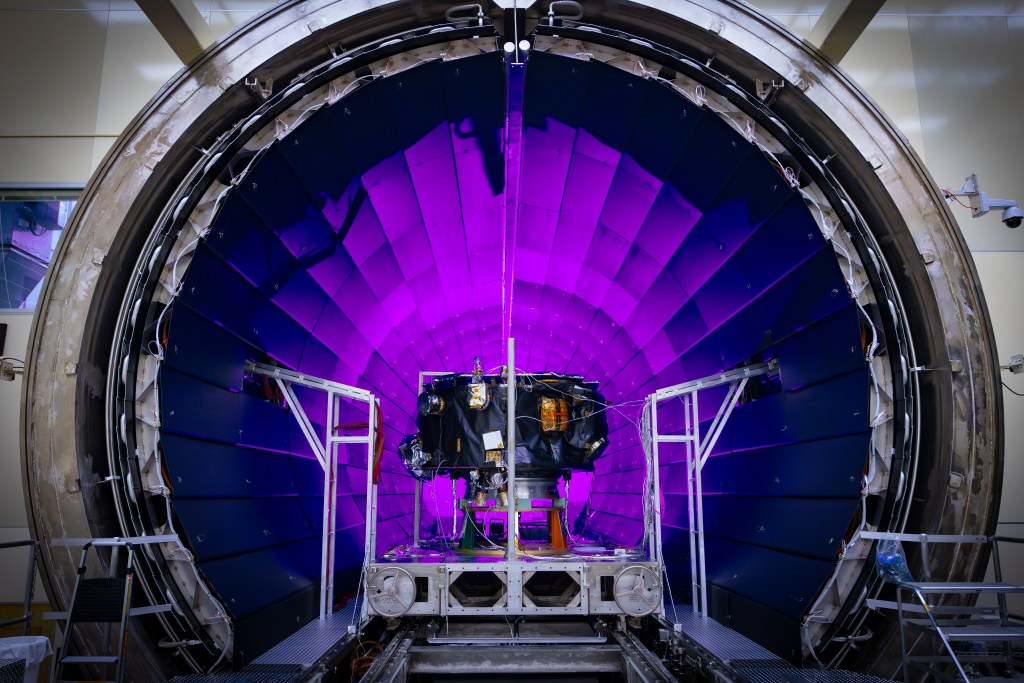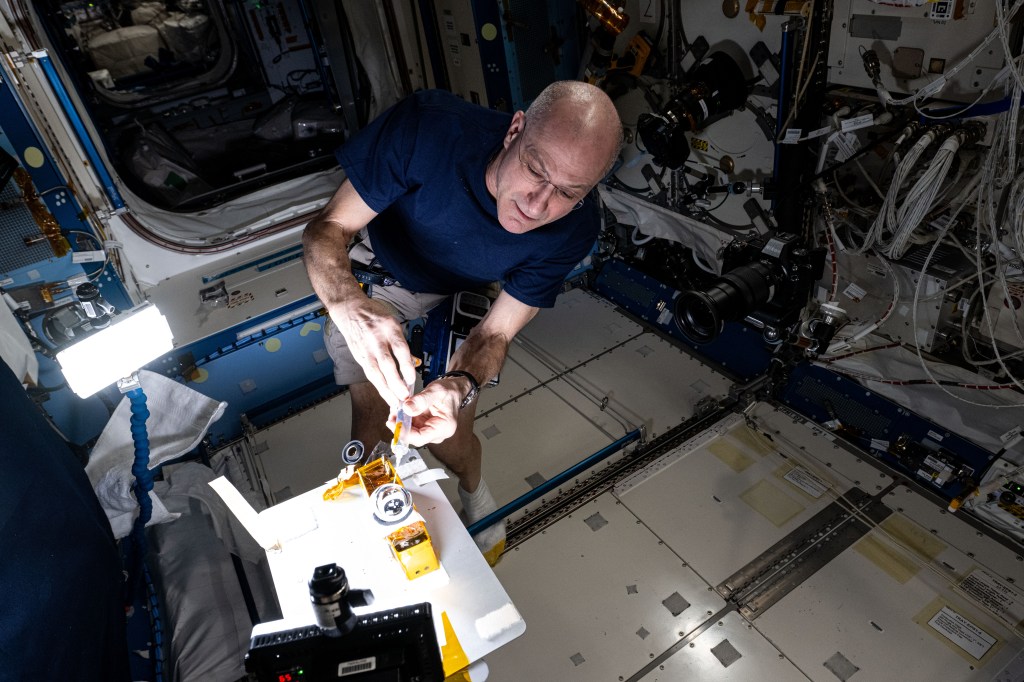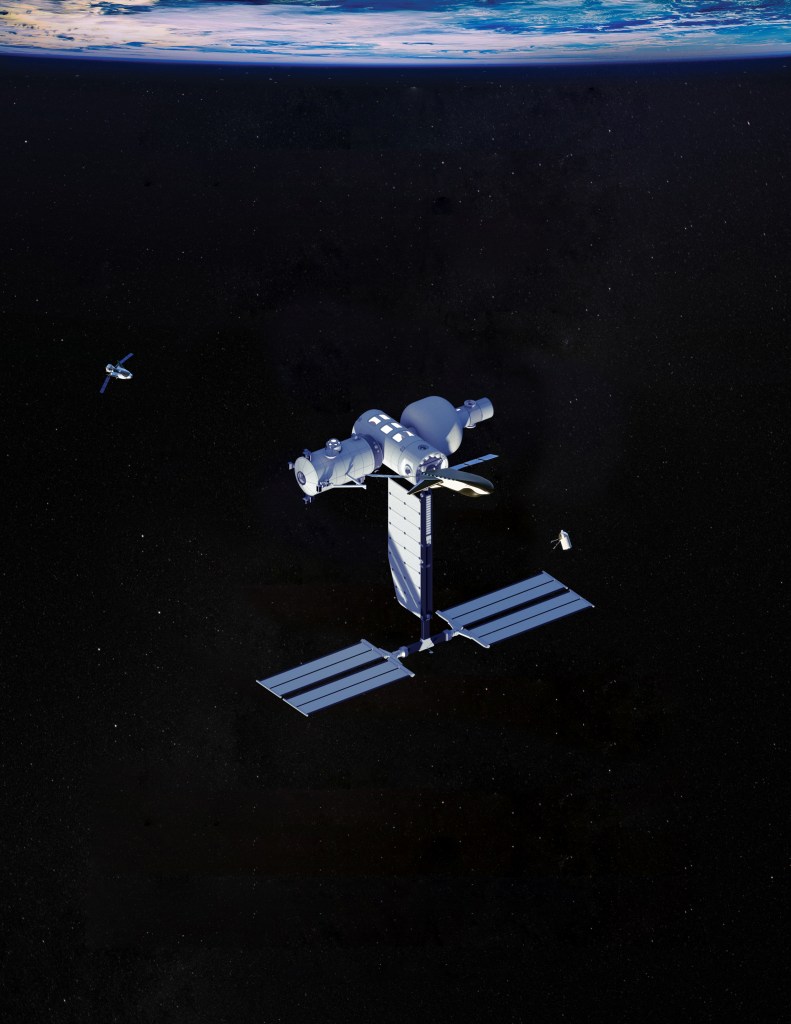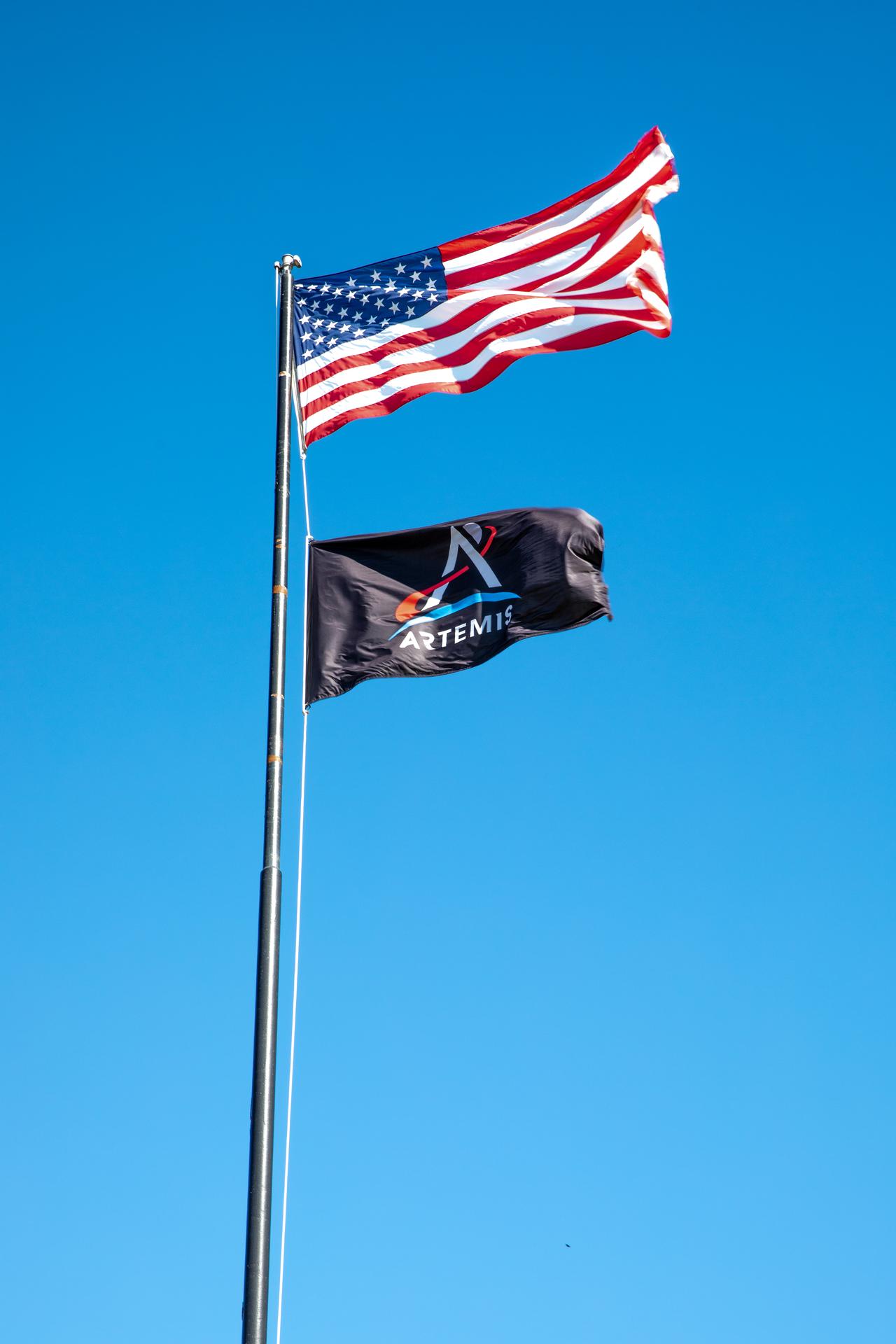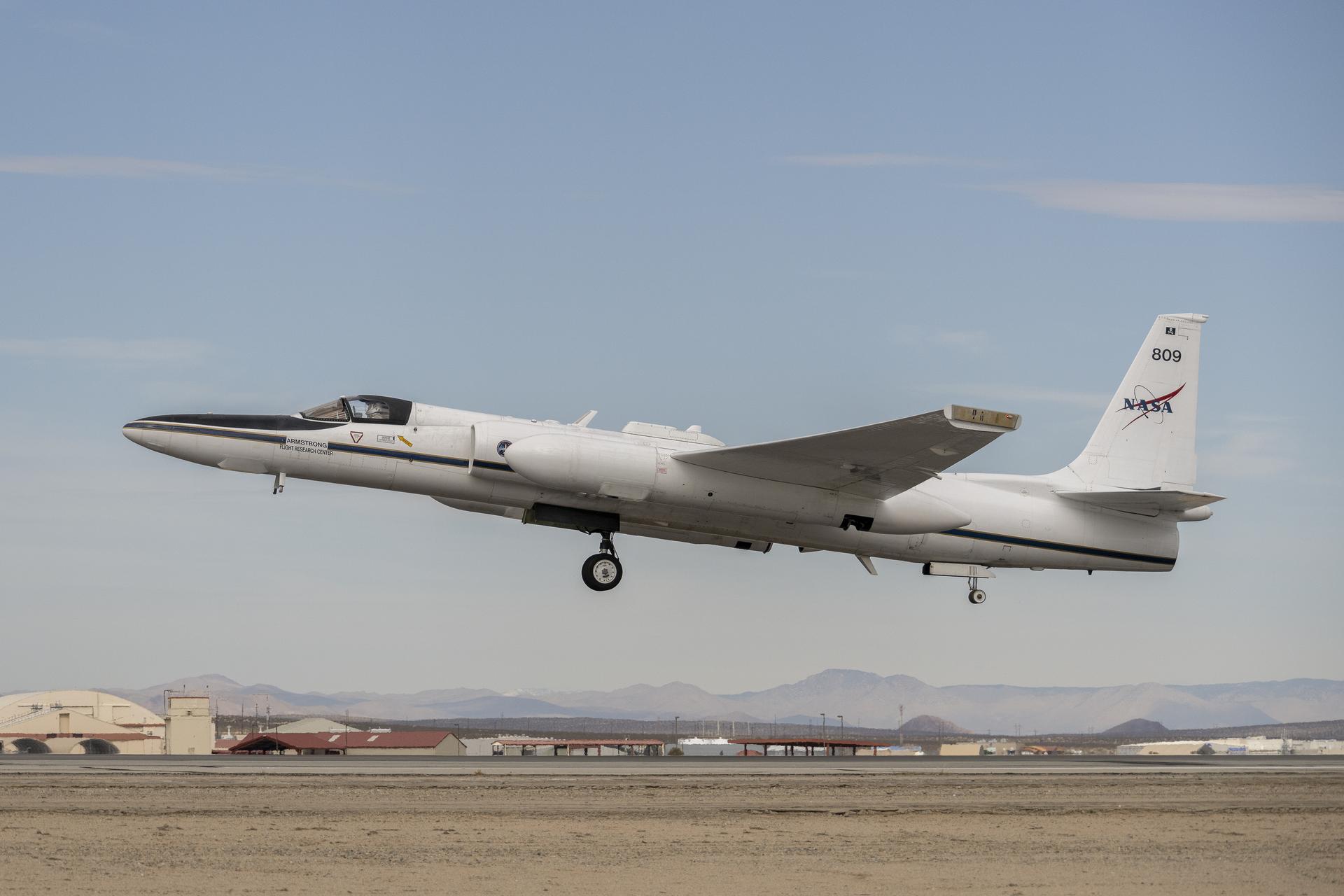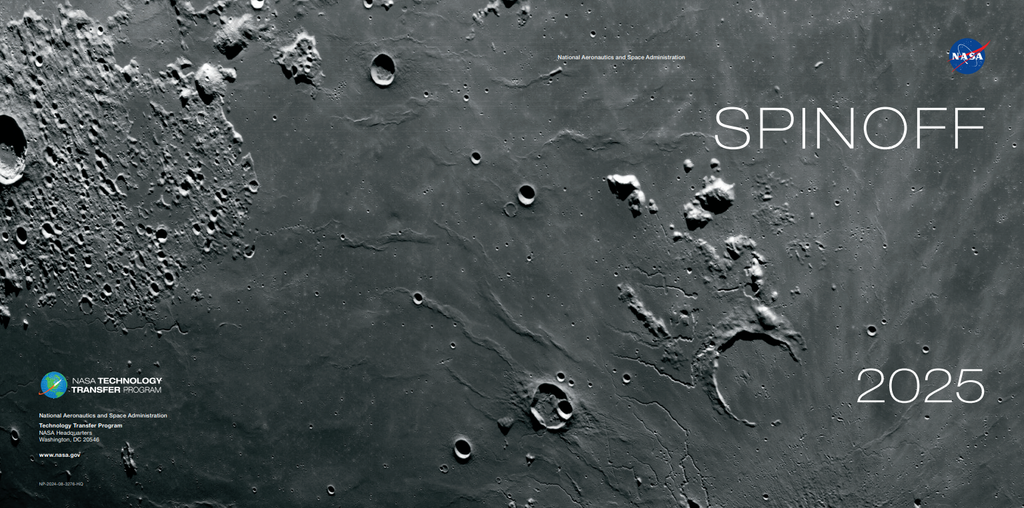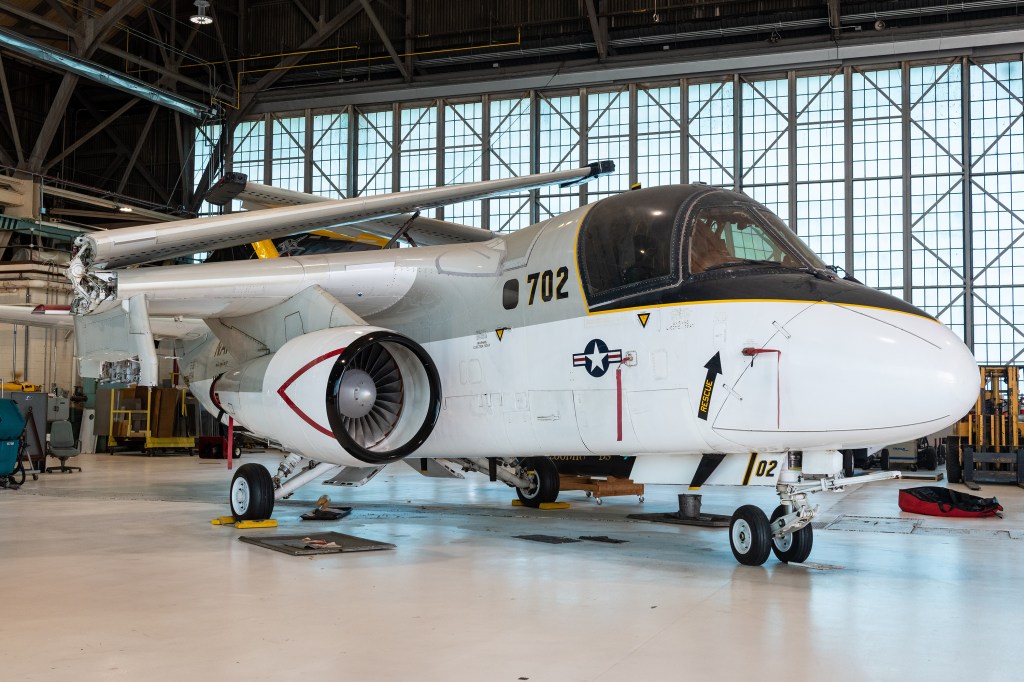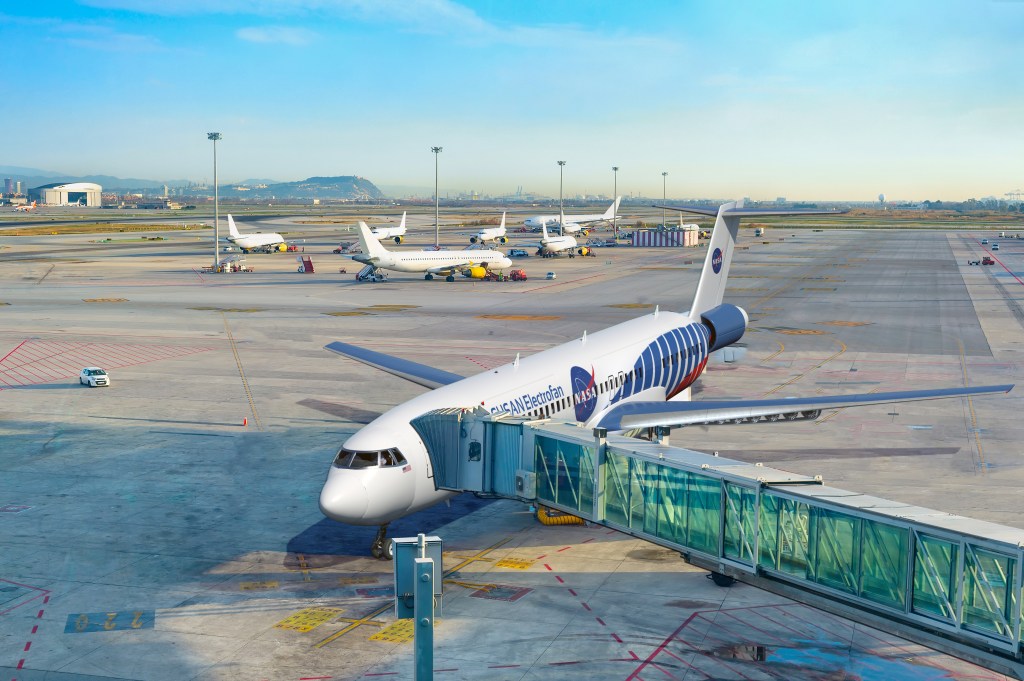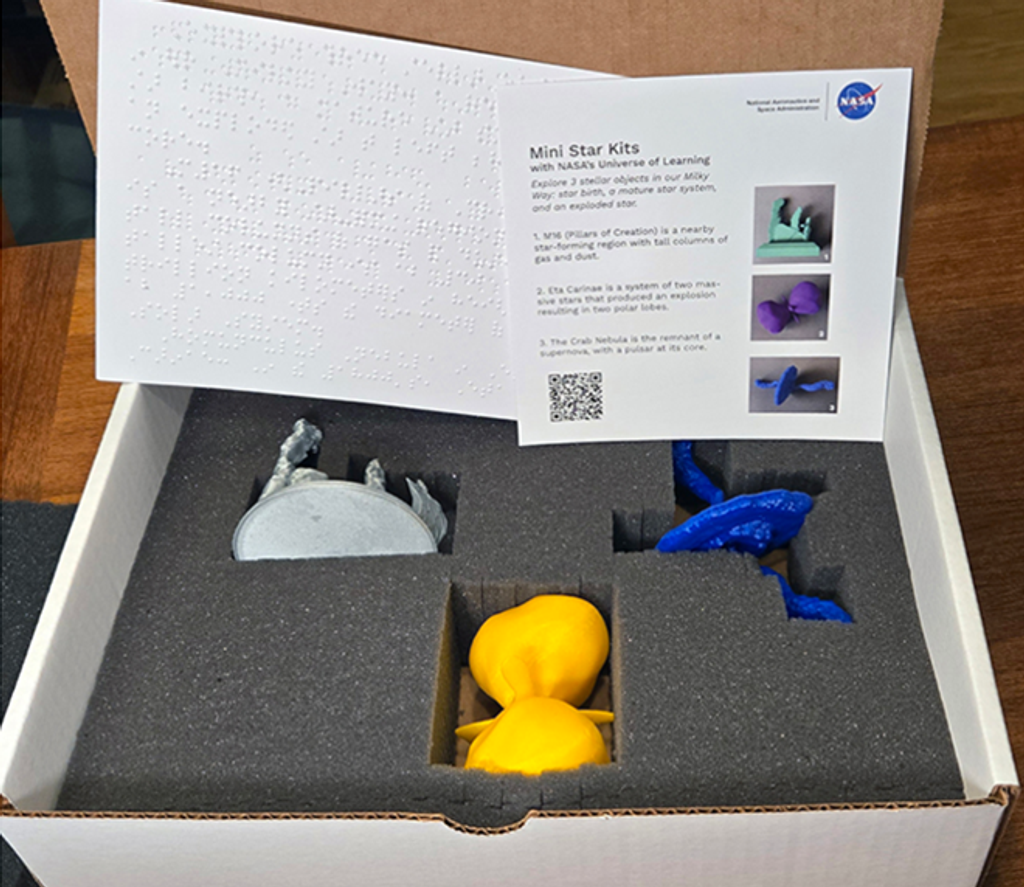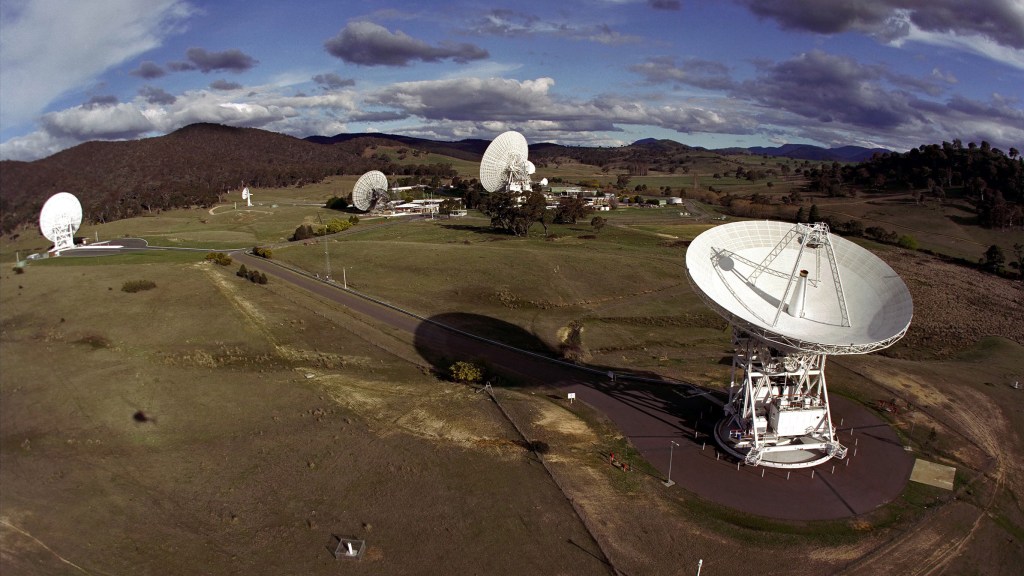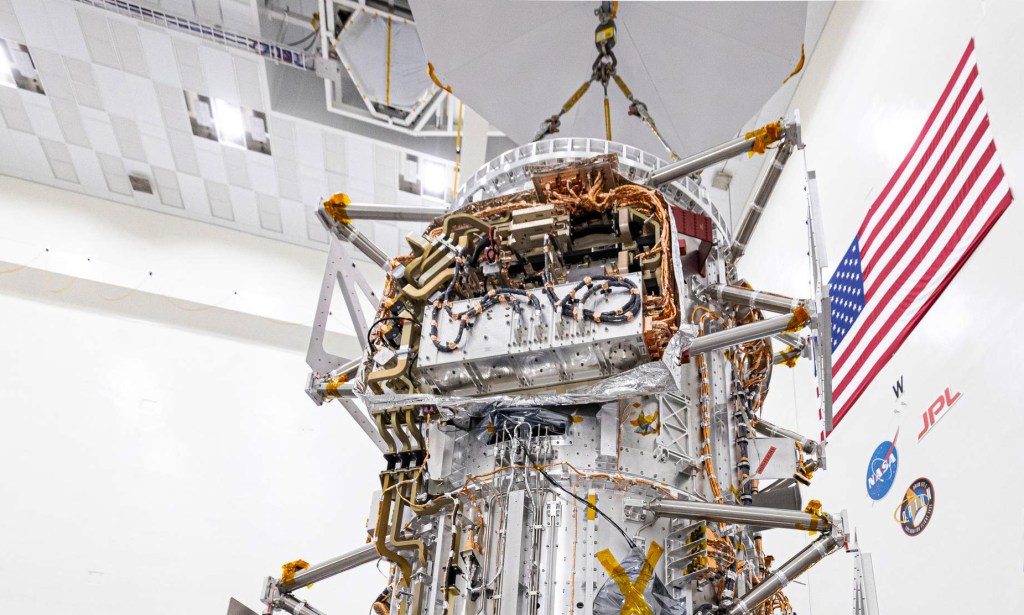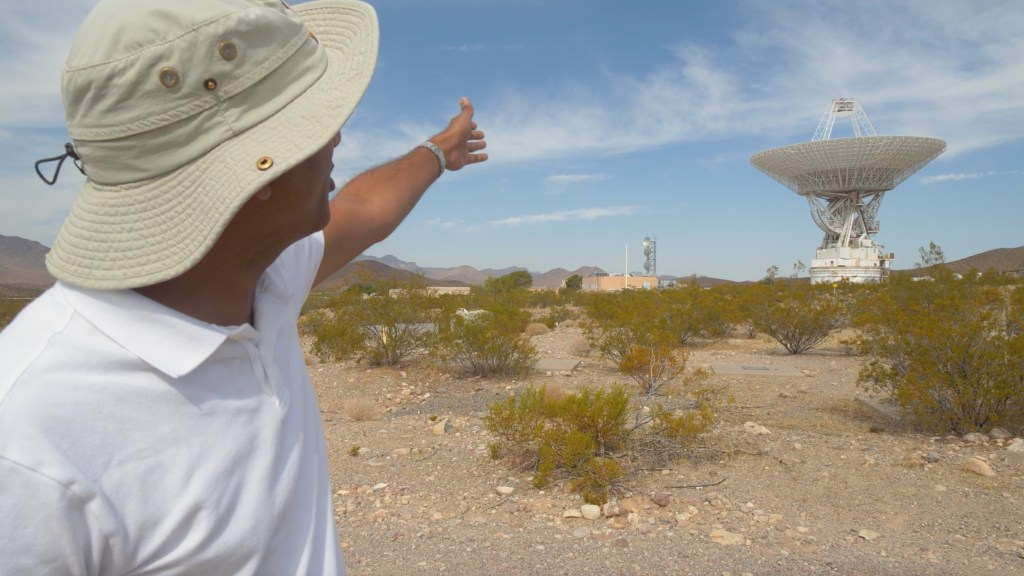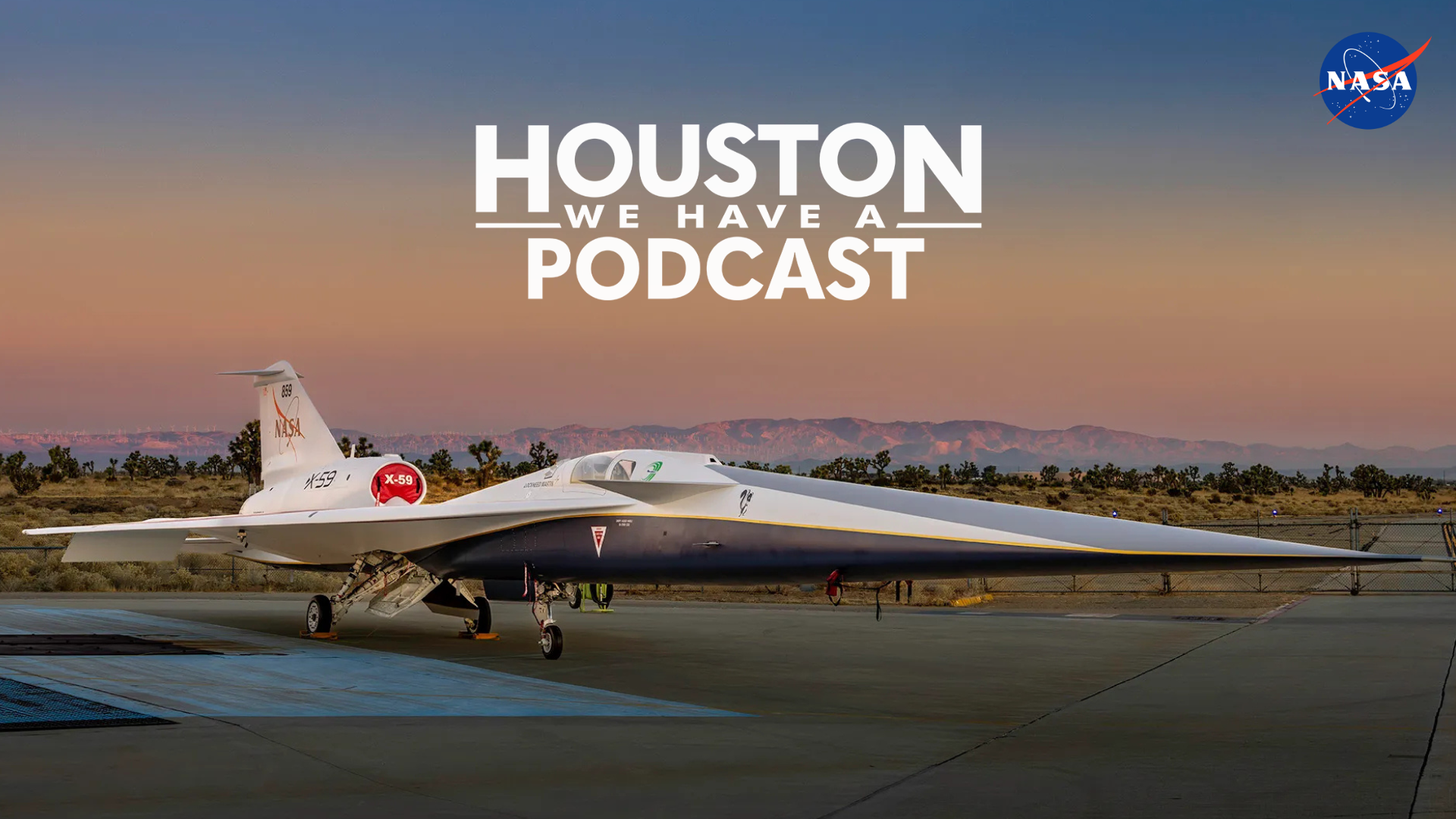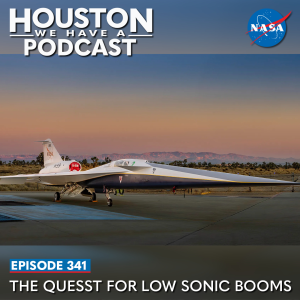
From Earth orbit to the Moon and Mars, explore the world of human spaceflight with NASA each week on the official podcast of the Johnson Space Center in Houston, Texas. Listen to in-depth conversations with the astronauts, scientists and engineers who make it possible.
On episode 341, aerospace engineers discuss NASA’s Quesst mission and the X-59 aircraft designed to fly faster than the speed of sound and test the future of supersonic travel. This episode was recorded on May 30, 2024.

Transcript
Host (Leah Cheshier): Houston, we have a podcast! Welcome to the official podcast of the NASA Johnson Space Center, Episode 341, “The Quesst for Low Sonic Booms.” I’m Leah Cheshier and I’m your host today. On this podcast, we bring in the experts, scientists, engineers, and astronauts, all to let you know what’s going on in the world of human spaceflight and more. Have you ever dreamed of boarding a plane and flying faster than the speed of sound, making it to your intended destination in half the time? It would open a new world of possibilities and accessibility for traveling long distances. But for the last 51 years, commercial supersonic flights over land have been banned over the United States. Why sonic booms?
NASA’s Quesst mission has the X-59 aircraft as the centerpiece, and it’s addressing the future of supersonic travel by tackling sonic booms. Designed to fly faster than the speed of sound without generating the strong shockwaves typically associated with supersonic flight, the slender design of the single seat X-59 enables it to produce a softer thump, opening the possibility of quiet supersonic travel by flying over several communities in the United States and gathering feedback on noise levels, the goal is to show that the X-59 can fly at supersonic speeds without the traditional sounding sonic boom. Researchers will survey communities below to ask that they weigh in on the sound that they hear, then provide that data to the FAA and international regulators to evaluate potential changes from a speed limit to a sound limit. The Quesst mission could pave the way for widespread commercial supersonic air travel over land, offering faster and more efficient transportation options for people around the world.
Joining me to talk about Quesst today are Cathy Bahm, the Low Boom Flight Demonstrator project manager, and Lori Ozoroski, the Commercial Supersonic Technology project manager. Both Cathy and Lori are aerospace engineers, focusing on supersonics making these two a dynamic duo to break down the Quesst mission and how it could change the game for us all. So grab your boarding passes and neck pillows, and let’s get started.
[Music]
Host: Hi, Cathy and Lori, thank you so much for joining us today on Houston We Have a Podcast. How are you doing?
Cathy Bahm: Great.
Lori Ozoroski: Great. Thanks for having us.
Host: Awesome. Well, before we start talking about Quesst today, I want to learn a little bit more about each of you, your backgrounds and your roles. Cathy, I think you started as an intern. So did I. Can you tell me a little bit about your journey and what you’re doing now?
Cathy Bahm: So I started as an intern from Texas A&M University and not too far from Houston. And I spent three semesters out at NASA Armstrong Flight Research Center. And my second semester, I got to work with a gentleman named Ed Herring. He was my mentor. And we actually recorded sonic booms in the desert of F-18s, SR-71s, and I just loved that so much. I came back the third semester and did it again. And so, then when I graduated, they offered me a permanent position in the flight controls area of the center. And so, I was working there for a number of years before I became a project manager.

Host: I can’t imagine being in college and going back after your semester interning and your friends asking, “What did you do during your internship?” And you say, “I measured sonic booms. No big deal.”
[Laughs]
Cathy Bahm: Yeah. I tried to downplay it when I got back to school. So not to make my other friends too jealous.
Host: That’s very nice of you. I can’t say I would’ve done the same. Well, I love that. Lori, how about you?
Lori Ozoroski: So, I think the first experience I had with NASA was in grad school. I was actually being supported by a research grant, working on a little bit faster aircraft than what we’re going to talk about today. But then after getting out of grad school I got a job at NASA Langley in Hampton, Virginia. And when I started, I started working commercial supersonic aircraft, and I have been working that for the last three plus decades now. So, I have a long tenure in mostly aircraft design studies, conceptual design, conceptual design methods, and this is really the culmination of all of those decades of work.
Host: Yeah, I would say so for both of you really. I mean, what incredible backgrounds. So now Cathy, you are the low boom flight demonstrator project manager; Lori, you’re the commercial supersonic technology project manager. What do your roles entail today?
Cathy Bahm: So for me, I am managing the design development and test of the X-59 aircraft. We are currently starting the integrated testing, and then we’ll go on to the flight test. Envelope expansion is part of the phase one of the mission. And the envelope expansion will make sure that the aircraft performs the way we expect and it’s safe to fly. And then I’ll support the X-59 as part of phase two of the mission where, kind of Lori’s project really, takes over and we’re just operating the X-59 to get Lori’s project the data that they need as part of phase two.
Lori Ozoroski: Yeah, so the project that I manage, the Commercial Supersonic Technology Project, we actually are the enduring research project at NASA involved in commercial supersonic. So the whole concept of the X-59 aircraft was born within our project. When the decision was made to actually build the aircraft, that’s when the project that Cathy manages now was formulated. And eventually, as Cathy mentioned, the X-59 becomes our research aircraft for doing future research, both for understanding our tools for designing these type of aircraft and then using it to do our research, testing in communities around the U.S. to gather response data to our quiet supersonic thumps.
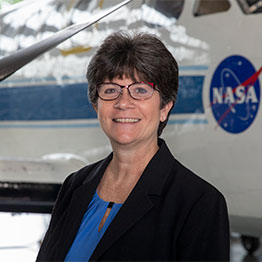
Host: Amazing. Well, thank you both again. Thank you for being here. And I want to start diving into Quesst and the X-59. So to talk about, really, the issue that this is addressing. Can you tell me about the ban on supersonic flight over land in the U.S.?
Lori Ozoroski: So, I guess I’ll take that one, Cathy. So there is a current ban on commercial supersonic flight over land, that ban is over 50 years old. As soon as aircraft, you know, broke the sound barrier, we started doing research between the Air Force and NASA back as early as the ‘50s and ‘60s to study the impact on of sonic booms, which a sonic boom is something that’s created during supersonic flight. It’s a very loud, impulsive, and very annoying sound that you’re subjected to on the ground. So we’ve done a lot of research back then. And although we kind of thought we had maybe some ideas on how to soften the impact of those booms, we didn’t have the ability to actually design aircraft that could do that.
So in 1973, the FAA instituted this ban on supersonic flight overland, so only military aircraft, and then only in certain locations and certain situations are allowed to fly faster than the speed of sound over land. And so that really has a big impact on the market available for any commercial supersonic flights. And, you know, we all know we had a commercial supersonic aircraft, the Concorde, but it was limited during its flights that it could not fly, say into, you know, somewhere in the middle of the U.S., you know, you were not allowed to fly supersonic over land. So most of the flights were back and forth just over the ocean. And so again, that ban has been in place for 50 years, over 50 years in the U.S. A lot of international countries as well have similar bans. And so the whole goal of this research that we’re doing right now is to lift that ban and set a speed limit for commercial supersonic aircraft rather than a speed limit.
Host: Okay. So a sound limit rather than a speed limit. Is that right?
Lori Ozoroski: That’s correct, yes.
Host: Okay. This is a big dream of mine. I would love to be able to fly. It is actually a bucket list item. I want to break the sound barrier. And so being able to fly supersonic, especially to a destination, would be incredible. And you mentioned the Concorde aircraft, but for this research, we are working with an X-plane, the X-59 specifically. So can you tell me a little bit about X-planes, how common are they? And then what is the X-59?
Cathy Bahm: So I’ll take this one, Lori. So X-planes are experimental aircraft that are used to test and evaluate new concepts and technologies. Each X-plane project is really designed for specific goals and to help advance the research in those areas. The first X-plane was the X-1. That’s the one that broke the sound barrier with Chuck Yeager and that was in 1946. So over 78 years ago, that aircraft was developed. The latest announced designated X-plane was X-66, also a NASA aircraft, the sustainable flight demonstrator actually. And so over these, you know, 78 years, there’s only been 66 designated X-planes. And so they’re quite rare. And even the ones you can be designated but never fly. So like X-33 was a NASA project that was designated an X-plane, but it never actually flew. So having an X-plane designation and then also getting to first flight is quite rare.
X-59 is specifically demonstrated, like Lori mentioned, to create a quiet thump on the ground, instead of the sonic boom that you normally hear with supersonic aircraft. And it’s really just, you know, the noisemaker to allow us to go into communities and test the response of those communities to that thump as Lori mentioned.
Host: Okay. I’m glad you mentioned the sonic thump. So I’ve heard some sonic booms in my lifetime with spacecraft reentering the atmosphere, and that’s typically two booms. Is that the same sound that you could expect from a sonic thump, or what does that sound like?
Lori Ozoroski: So yeah. Probably the sonic booms you’ve heard, that they do have a boom boom kind of a sound. The sonic thumps that are expected from the X-59 are much quieter and they don’t have quite that impulsiveness that you would get from a normal sonic boom. So the startle factor is lower, and the sound level is more like—we’ve done studies—it’s more like a car door closing, you know, across the street at your neighbor’s house rather than the very loud typical sonic boom.
Host: Oh, wow, okay. That’s significantly different than a sonic boom. I mean, when I heard them, I mean, you feel it, you know, in your chest almost. So that’s quite different in that comparison. I mean, how impressive is that? So I want to paint a picture for people of what the X-59 looks like, and I’ve seen pictures of it. This is a really elongated little jet. It has a super long nose. How long is the nose on the X-59 and why does it have to look like that?

Cathy Bahm: So the X-59’s nose is about one third the length of the aircraft. And it’s designed like that, all of the outside shape of the aircraft is specifically designed to create this sonic thump. It’s designed to control the strength and the placement of the shockwaves that are coming off the aircraft so that they don’t merge and generate that traditional sonic boom. And so we’re shaping the aircraft specifically to do that. So the nose is really long so that the shockwave that comes off the nose doesn’t merge with the shockwave that’s from the wing, like you would typically have and that would make it a much stronger sonic boom on the ground. So because it’s elongated, it doesn’t merge and you end up with the sonic thump on the ground.
The other distinctive characteristics are, if you were to look at the bottom of the aircraft, it’s very smooth. We’ve tried to move everything we can to the top of the aircraft to prevent more shock waves coming off the bottom of the aircraft. And so things like the environmental control system ducts, they’re on the top of the wing. The engine, we have a modified F-18 engine that we are using for this aircraft and it sits above the wing, and that is so that the inlet shock goes up, but it doesn’t go down. The wing prevents the shock that you would normally have coming off of an engine if it was under the aircraft because it’s shielded by the wing, you won’t get that shockwave contributing to the noise associated with our thump on the ground. And we have a small T tail at the top of the vertical tail, and that is to tune the shocks at the aft end of the vehicle. And so everything associated with the design of the aircraft is to tailor that thump on the ground.
Host: Got it. That makes sense. And so when I’m looking at the rest of the aircraft, there’s also not really a window for the pilot to look out of. So what kind of technology are you using for the pilot to actually pilot this aircraft? What kind of data are they reading?
Cathy Bahm: So we have developed a NASA system called the External Vision System. And due to the design constraints to make it very sleek and control those shockwaves, we are reusing a T- 38backseat cockpit. And so with the long nose and using that cockpit, you cannot see out. So the External Vision System uses a 4K camera system on top of the nose. And then when we’re near the ground, there’s also a forward vision system that comes out from the bottom of the aircraft. And the pilot actually watches an ultra-high def display in the aircraft in the cockpit. And the pilots have been using this in our simulation, and they’re just loving it because it gives them the view, but also it provides a lot of information that you wouldn’t normally see except for like a heads-up display. But all of that is integrated onto this one display that the pilots are using to look outside the aircraft.
Host: Okay, okay, that makes sense. So, because when I look at the X-59, it actually does look like an elongated stretched out T-38 a little bit. And we have some experience with those here at NASA Johnson, because that is what our astronauts train in and practice real-time decision making on the fly, literally on the fly. So you’ve got a T-38 backseat cockpit and it’s just a one seat aircraft on the X-59, is that right?
Cathy Bahm: Yeah, that’s correct. One seater.

Host: Okay. Wow, that’s really impressive. The ultra-high def display allowing them to see everything out in front. So you’ve got one person in the X-59, they are taking off. How fast does this thing fly and when it gets up to its cruising speed, what are you looking at in that speed range?
Cathy Bahm: So our test point will be Mach 1.4, or approximately 925 miles an hour, at an altitude of 55,000 feet.
Host: Okay. And to put that into context, 55,000 feet… For a typical commercial airline flight, you’re looking at about 37,000 feet, correct?
Cathy Bahm: That’s right. So this one will be flying much higher. And that’s partly the design constraints for the engine allow it to go to this Mach number. And then also the characteristics of the sonic thump on the ground will kind of mimic the characteristics that you would see in a commercial supersonic aircraft, you know, in the future.
Host: Oh, okay. Great. So we’re going to have to take what we learn here and apply that to future design of commercial aircraft, because when we talk about the Concorde, I’m guessing it made sonic booms, is that correct? I mean, it probably didn’t have the technology to make just these thumps that we’re talking about, right?
Lori Ozoroski: Yeah, definitely made sonic booms.
Host: That’s right. I think I’ve read some stories about broken windows and things like that. Let’s see. So we’ve gotten introduced to the X-59, and that was partially through a rollout event. Can you tell me a little bit more about it and how it went?
Cathy Bahm: So the rollout event was really a special occasion for the X-59. The team has been working on it for many years, and this was really our chance to kind of step back and introduce it to the world as a fully integrated aircraft and kind of celebrate all of the hard work that the team has been doing over the past few years. But it was even more than that. It was really exciting because it was introducing this aircraft that really leverages, like Lori was mentioning, decades and decades of the hard work of NASA and our other team members, industry members. And so we’re leveraging so much of what was done in the past. And so it’s kind of introducing that aircraft and then it’s also a harbinger of the great things that are to come our first flight later this year and all of the great things that the mission will do. And so it was really an exciting time. And Lori was there as well, and she might have a different perspective cause Lori’s not there, like on the day-to-day, you know, I see the aircraft all the time. So it was really neat to step back. But Lori might have another perspective on it.
Lori Ozoroski: Yeah. Yeah. And Cathy, thank you for the invite to the rollout. Yeah, I think Cathy and her team, they live and breathe that aircraft on a daily basis and see it all the time. And it had been quite a long time since I had seen, you know, the aircraft in an early build status. So being there for the rollout for me was, you know, it’s really exciting because, you know, you just start wondering, oh, I can’t wait, you know, the excitement for us because we are going to get this aircraft, which is an amazing looking aircraft, by the way and really be able to make those final pushes forward on the research side using this vehicle. So it was definitely very exciting. And I think even, you know, emotionally for me, I think one of my most emotional days at NASA was when we learned we had been approved to proceed with this aircraft. So this became then my next most emotional day being able to see that aircraft in its complete status. And it’s just so exciting thinking about where we’re going. And as Cathy said, the people that have been involved in making this happen for not just the last few years, but the last few decades.
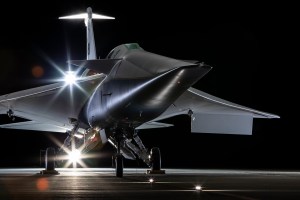
Host: Wow. Yeah. I mean, this could really change the future of air travel, and we’ll talk a little bit more about it later. But when you see it at a rollout event like that, and there’s, you know, excitement built around it, and you are looking at the physical product, I think must hit like, this is really real. This is really happening. And you’ve talked a little bit about this is truly decades of research that have gone into preparing for this aircraft, but if we can hone in a little bit more on the X-59, I guess, how long would you say it’s taken to develop the X-59 specifically?
Lori Ozoroski: I would say, so we did initial studies when we got to a point where we thought we had the capability to design an X-plane that could do this research. I think that was probably over 10 years ago. And then we did some initial studies, some refinement studies until we did settle on this design and put Lockheed-Martin under contract to build the aircraft. So it has been going on over, you know, the early designs through where we are today has been over a decade in the making.
Cathy Bahm: Yeah. And we put Lockheed on contract for the X-59 back in 2018. So it’s been a long time in the making in addition to, like Lori said, the initial studies leading up to that contract award.
Host: It’s funny, I think that’s probably when I started being more aware of this project was 2018 and you said a decade, and I’m just now realizing that’s 2014, that’s really not that long ago. It feels like it would’ve been so much longer ago. So I’m really glad it’s come to fruition. So we have the aircraft, and now you are looking at testing, but there’s been a little bit of testing already. From what I understand, you did some testing over Galveston here in Texas, which for our listeners outside of the state, that’s just south of Houston, and you took off from Ellington Field, which is associated with NASA, that’s where we train our astronauts in T-38s. And we have some other aircraft like the WB-57s or the G5. So what was that testing that happened over Galveston? When was that and what did you look for there?
Lori Ozoroski: So I don’t, you know, ultimately with the X-59, we’re going to use it to actually gather data from, you know, the community on the ground to how they feel about these sonic thumps in the different levels that we exposed these people to. So back in 2018, in the fall of 2018, we did what, you know, a practice test to learn what would be involved in going out into a community recruiting individuals on the ground to respond to surveys as we were flying the aircraft, learn about deploying for doing one of these tests. So it was a two plus week test that happened. We were flying out of, as you said, out of Ellington, we had ground recorded quarters, you know, systems as Cathy was talking about, what she got to use her first internship at NASA Armstrong recording equipment on the ground throughout the community. And we were recording sound levels, surveying the participants, and then correlating that data to try to understand the annoyance. But we weren’t really trying to gather what I would call scientific data during that test. It really was a sort of a dress rehearsal and a risk reduction test for our future community testing with the X-59.
Host: Yeah, that makes sense. So what did you fly in 2018 over Galveston, since it wasn’t the X-59?
Lori Ozoroski: So over the years we have, I would like to say perfected a dive maneuver that we do with an F-18 that does a pretty good job of stimulating one of these low sonic thumps. But it doesn’t create a consistent exposure for a large area on the ground. So it does vary a lot, and that makes it very difficult to estimate a specific exposure of somebody that might be five miles away from, you know, there’s a large area where we’re exposing people. But for that test we were using, we actually had a few F-18s this maneuver flying out over the ocean, going into the dive maneuver. And then the people we had monitors out as far as I want to say Texas City, you know, so we were hitting everyone from the coast to further locations inland with these low sonic thumps.
Host: Okay. Very neat. I wish I could have been part of that. I’m looking forward to the future testing. So let’s talk a little bit more about that. You are going to fly the X-59 over a community. How does this acoustic testing happen? How many times will the plane fly over the community? Are you telling people beforehand? Are you just kind of seeing if they’ll notice and report it later? How are you going to measure all of that?
Lori Ozoroski: So our community tests are planned for about a month long. We will be targeting about 60 flights over a community, you know, one to three a day. The people that we will be surveying, we have a contractor who is an expert in actually executing surveys. So they actually will send out letters to the community and people can sign up to participate in the survey. We actually do give incentives for people to respond to the surveys and continue to respond to the surveys throughout the entire test cause that’s really important for us to get a full data set from a participant with them responding to individual sounds that they hear. And there’s also a cumulative effect that sounds, so you get used to a sound after a while. And so while it may annoy you at the beginning, you know, a month later, it may not be annoying you as much cause you’re used to hearing the sound.
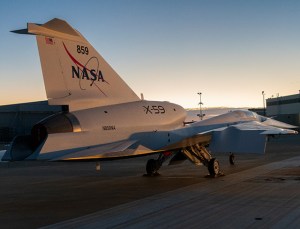
So we will actually have participants registered that will participate in the survey. We will send out after we have flown a pass or maybe some false notifications, we’ll notify the participants and they will fill out a survey, you know, talking about how annoyed they were, what they were doing at the time, were they in their house or were they, you know, driving their car or things like that. Hopefully they’re not filling the survey out while they’re driving their car, but things like that. And then we will take those responses and correlate them with the exposure level that they have, that we predict that they, or measure, that they experienced on the ground. And that’s what will feed our database of information that ultimately, we will provide to both the FAA and international organizations responsible for regulations. So it’ll be an interesting survey and we’ve got plans to do five tests around the country. However, the first one will be based out of Armstrong, our NASA Armstrong Facility at Edwards Air Force Base as a risk reduction for deploying on our first test. But then we will be going to at least four other communities around the U.S. to do our testing.
Host: Okay. I’ve been to Armstrong and it is definitely a good first place to test if you’re not looking to disturb too many people. It’s pretty far out there.
Lori Ozoroski: Well, so, when we actually test, the aircraft has about 125 mile or more range. So we actually will operate out of an airfield, but we won’t actually test in that vicinity because it’s important. We don’t want to be testing above, you know, exposing people that are used to. If you’ve been to Edwards Air Force Base, you have probably get a lot of sonic booms. So we will actually be testing in a community that’s within that maybe 125 mile radius of Edwards Air Force Base. It’s very important for us to not be surveying people that have some existing, maybe bias towards various noise sources.
Host: Yeah, good points.
Lori Ozoroski: Just somewhere in Southern California. All we can say.
Host: Keep your ears out, everybody. No, I mean, that makes sense because they may not even notice a sonic thump, considering how often they hear sonic booms out there.
Lori Ozoroski: Right.
Host: Okay. So when you are talking about these communities, so you’ll test somewhere in Southern California, you mentioned that one, but what else are you looking for in a community that makes it a good candidate for somewhere to test?
Lori Ozoroski: Yeah, so as I mentioned, there’s really two components. There’s an airfield that we can operate the X-59 out of, and then there’s the community where our survey participants will be located. So the first thing we have had to do is look at the, you know, there’s a lot of operational limitations of the aircraft or some safety requirements that we’ve had to consider to identify actual airfields around the country that we can operate out of. We are always learning more things that kind of, you know, impact, what airfields are viable for us to test, to operate from. And then in the survey communities, it’s really important for us to gather the most representative data that we can. So one of the first things we are looking at are climate regions. You know, the housing construction in Florida is probably different than housing construction in Montana or Idaho. You know, there’s cold climates, warm climates, the way houses are built, you know. All of those things actually will contribute to your annoyance, you know, what you’re hearing and experiencing, with these sonic thumps. So that’s the first thing. So we will be trying, we will be testing in a variety of different climate zones. And then the next thing is really for representative demographics. So it’s very important for us to understand and be representative in the age, the race, the affluence, whether someone’s in a urban or suburban or rural community. There’s a lot of those sort of things that go into being able to develop a statistically relevant database. So we’re balancing all of those things and if things are a little off in one test, we’ll be trying to make sure that the next community we balance things out.

The other aspect really is because commercial supersonic travel is an international issue, right? It’s something that, you know, you’re going to be flying from country to country. So, you know, ultimately we are going to be providing this data to international regulators. So as part of that, it’s very important for them, the data that we collect to be acceptable to and relevant for an international community. So one of the other things we are in the process of doing is trying to identify an international partner to go to another country and do a test that would hopefully then help make it more acceptable. We’ve gotten a lot of feedback from the international community on our methods that we’re using for our survey and what we are putting into identifying these locations. And we’ve learned some interesting things. But, you know, that’s a really important aspect of these surveys, is making sure that they are representative and we’ll be accepted by the international community.
Host: Yeah, that’s really interesting. I never thought about how the construction of a home based on your climate affects what you might hear. I think that’s so fascinating. So when you have determined the communities, when do you think the testing will begin? You said later this year, is that correct?
Lori Ozoroski: Well, so Cathy’s project will be flying the aircraft later this year, but it’s going to take Cathy, I don’t want to, you know, speak for you, but it’s going to take it probably about a year to prove the airworthiness of the aircraft, which is very important if we’re going to take this out over out across the country and be flying it over populations. And then once we have gotten to that point, we actually have another phase of the mission where we will be doing a lot of acoustic measurements, measuring all of the sounds coming off the aircraft, understanding the shock structure underneath the aircraft, and so that we fully understand the acoustic characteristics of the aircraft and also gather data so that we can actually validate those tools that have been used in the process of designing the aircraft, because those are the tools that will be used by industry to design a future commercial product. So there’s a lot of work that’s going to go into understanding the sounds that this aircraft will make. So that’s probably going to take, again, nine months, maybe not, hopefully not a year, but about nine months. And then once that phase is complete, that is when we would then take this out into the community. So it’s going to be a couple more years yet before we are in communities doing these testing.
Host: Great. Okay. So let’s say you’ve done the testing, you have the data. Now what, you know, you’re looking at everything you’ve learned, you’re looking at what reports you’ve gotten back from the community. How do you take this and eventually present it and say, “We think that supersonic flights should be legal over land for commercial flights.”
Lori Ozoroski: So it’s not really NASA’s job to make that assessment. We are actually just going to provide information that says at this sound level, you know, people are not annoyed as the sound increases, it’ll get to a point where there is a very high annoyance being, you know, the high annoyance response to a sound level. So even though this aircraft X-59 is designed for a particular low sound level, we will actually be, during our testing, we will be generating a wide range of sonic thumps with the aircraft and basically just we’ll be able to establish some distribution. NASA will then present that to the FAA and the ICAO, the International Civil Aviation Organization, that will then, with all of the international participants, will look at that data and will suggest and propose a certification level. And there’s a lot more that goes into how you would actually certify that aircraft, which NASA is involved with all the international partners. But really, we will just provide this information. It’s up to the regulatory authorities to establish what that level is.
Host: Okay. That makes sense. So this is typically NASA as an agency, you know, we are doing the work and then we’re able to provide what we learn to someone else to make decisions based on that. So that makes sense. So let’s all think about our dreams coming true and someday in the future, supersonic travel over land is legal again, how long would it take to fly across the country?
Cathy Bahm: So if you were going from New York to Los Angeles, it would take about half the time, so under three hours to fly supersonic across the country. So, you know, our dream coming true, like you said, you know, is that you can get to your vacations in half the time. You can get to, you know, work meetings. You could do a work meeting on the west coast and still make it home for dinner. You know, a one-day trip for a face-to-face meeting on the other side of the country. And then because it’s half the time you can get to further, right? Twice the distance in the same amount of time. So the whole world kind of becomes smaller, more accessible, you know, these far off places that you’ve always dreamed of going to. You can get there in half the time that you would get there now. So it’s a really exciting future.
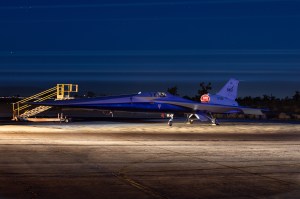
Host: That is—oh my goodness, it’s so exciting. Truly exciting to think about when I mean, I have trips planned right now that I wish were shorter flights. And so just to think about the opportunity of someday being able to get on a plane and go see family at a much quicker rate, or like you said, travel to places that do feel out of reach because of a flight time just to so significantly decrease that, it truly feels like a dream. I don’t know another way to say it right now. So besides those shorter flight times, are there any other improvements that travelers could expect on supersonic flights?
Lori Ozoroski: So, you know, we’ve talked mostly today about Quesst and the X-59. My project actually works a lot of other technologies that are considered to be enabling for future commercial flights. And, you know, there are additional barriers. We’ve said for years that we thought that sonic boom was probably the biggest barrier and the biggest impediment to having a viable commercial supersonic market. But there’s also other challenges with landing and takeoff noise. These aircraft are going to need to be quiet. They’re not generally quiet on takeoff and Concorde was very loud. But we need to make sure that the noise, not just our en route noise, but that our takeoff and landing noise around airports and communities at the ground are comparable to today’s existing subsonic aircraft. So we do a lot of work trying to understand and reduce the noise for supersonic aircraft. There’s also, of course, you know, emissions is a huge thing, you know, sustainability. So we are doing research within, well, there’s a lot of research going on at NASA in as far as sustainability is concerned, but within the supersonic technology project, we look at, you know, ways that we can be, you know, burning fuel more efficiently, understanding how sustainable aviation fuels work in our engines, and how we can make the aircraft themselves more efficient, reducing drag and basically reducing fuel burn. So the amount of fuel that we’re burning and causing creating missions with. So there’s a lot of other things that we are tackling within NASA along to help enable this future commercial supersonic industry.
Host: Wow. Thank you both so much for breaking all of that down for us. And I know that this is really just the tip of the iceberg of what you’ve been working on, of what’s to come for the X-59 for the Quesst mission. So if we have anyone interested online, where can they go to learn more?
Cathy Bahm: So they can follow along with our progress at www.nasa.gov/Quesst. And that’s with two S’s for supersonic. You can even sign up for a boarding pass to be part of the X-59’s first flight. You can meet the team. There’s tons of photos and videos and you can learn more about the mission at that website.
Host: I will definitely be signing up for a boarding pass. Unfortunately, I don’t think that means a seat this time around, I’ll be signing up for my name to be carried on the flight and hopefully for future flights that are supersonic across land because of the work that y’all are doing today. So a really big thank you for everything that you and your teams have poured into this. I am so excited to continue following this mission over the next couple of years as you go through testing and eventually gathering and reading and seeing the data and what we’ve learned through it. So thank you both so very much for joining me here today on Houston We Have a Podcast and we can’t wait to see what’s next for you and the Quesst team.
Lori Ozoroski: Thanks for having us.
Cathy Bahm: Yeah, thank you.
[Music]
Host: Thanks for sticking around and I hope you learned something new today. Check nasa.gov for the latest information, and you can also find us on nasa.gov/podcasts. We’re also on Johnson Space Center social media on Facebook, X, and Instagram. You can use #AskNASA on your favorite platform to submit your idea and make sure to mention it’s for Houston We Have a Podcast. This episode was recorded on May 30, 2024. Thanks to Will Flato, Dane Turner, Abby Graf, Jaden Jennings, Kristen Hatfield, and Gary Jordan. And of course, thanks again to Cathy and Lori for taking the time to come on the show. Give us a rating and feedback on whichever platform you’re listening to us on and tell us what you think of our podcast. We’ll be back next week.
This is an Official NASA Podcast.




